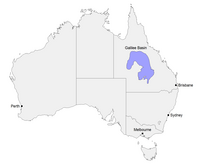
Photo from wikipedia
Abstract Although Jurassic-Early Cretaceous sedimentary systems were extensively developed on northeastern Gondwana, deciphering their paleogeography has been complicated by poor exposure and the lack of a robust chronostratigraphic framework. The… Click to show full abstract
Abstract Although Jurassic-Early Cretaceous sedimentary systems were extensively developed on northeastern Gondwana, deciphering their paleogeography has been complicated by poor exposure and the lack of a robust chronostratigraphic framework. The southeastern margin of the Carpentaria Basin, northeastern Australia is one of the few regions where these sedimentary systems are extensively exposed. Employing a combination of facies analysis and new data from paleontology and detrital zircon geochronology, we present a temporally and environmentally refined paleogeographic framework for this region. A Late Jurassic, southeasterly directed marine incursion invaded northeastern Gondwana, extending inland across the Carpentaria Basin, as demonstrated by a thin (~ 30 m), marine influenced (fluvio-estuarine) stratigraphic succession capped by a sequence bounding ~30 myr paraconformity. The depositional hiatus marked the Late Jurassic-Early Cretaceous uplift of the Euroka Arch, with loss of sedimentary and fluvial connectivity between the Carpentaria Basin and adjoining Eromanga Basin. Subsequent deposition by low-accommodation fluvial systems resulted in a thin, fluviatile depositional package developing during the Early Cretaceous. Paleocurrent and provenance data indicate that the Middle to Late Jurassic (c. 170-160 Ma) fluvial systems predating the paraconformity extended from the Eromanga Basin to the south across the southeastern Carpentaria Basin, transporting sediment from distal sources in the Lachlan Orogen of southeastern Australia. Fluvial systems of the southeastern Carpentaria Basin post-dating the paraconformity and Euroka Arch uplift show a provenance shift to easterly sources in the Mossman Orogen and Kennedy Igneous Association. Previously unrecognized Jurassic-Early Cretaceous igneous activity provided a persistent source of sediment to the southeastern Carpentaria Basin succession due to reworking of air fall tuff from an active magmatic arc located on the continental margin of northeastern Gondwana.
Journal Title: Gondwana Research
Year Published: 2020
Link to full text (if available)
Share on Social Media: Sign Up to like & get
recommendations!